15+ Eye-Opening Supercomputer Statistics That You Should Know In 2023
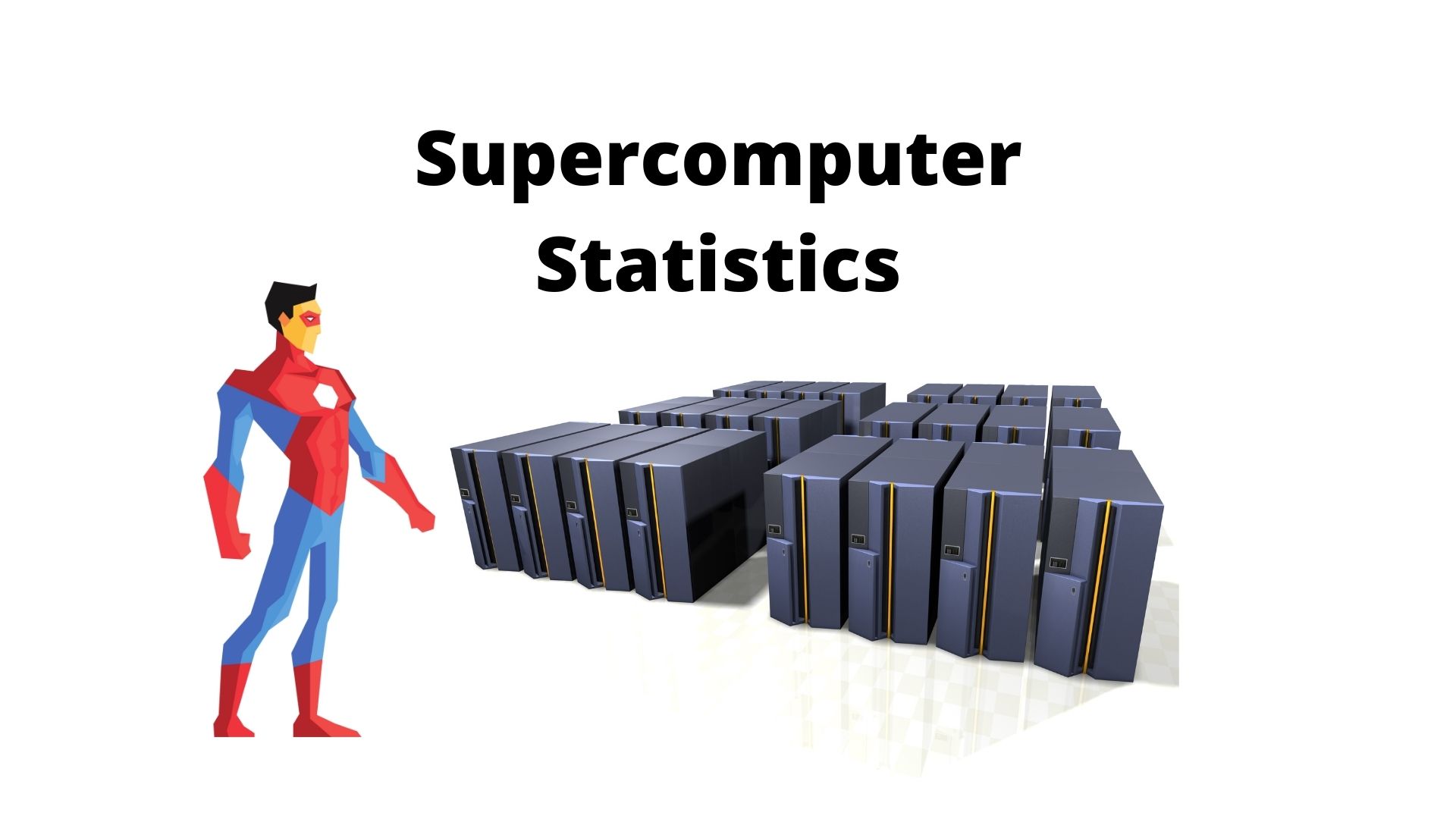
Page Contents
Supercomputer Statistics: There are still a lot of issues to be solved and many processes to be improved in our world. Even while computers solve millions of problems every day, there are always new ones that need our attention.
Supercomputers are an essential part of any discussion on large-scale issues since they solve an unimaginable number of problems every second to enhance our quality of life.
In this article, we will discuss some fantastic supercomputer statistics. Also, we learn about some of the most potent electrical devices- their history, future, and definition.
Key Supercomputer Statistics and Facts (Editor's choice)
- Cray-1 was released in 1976, and it stands six feet tall with a diameter of seven feet.
- IBM Summit can perform 200 quadrillion calculations per second.
- The global supercomputer market generated $6.26 billion in revenue in November 2021.
- More than half of the top 500 supercomputers used Linux as of June 2021.
- China had 173 of the top 500 supercomputers that were the most powerful worldwide as of November 2021.
- The Chinese Oceanlite supercomputer boasts a peak performance exceeding 1.3 exaFLOPS.
- Right now, Frontier is the world's most powerful computer in 2022.
- The TOP 500 list still places the Fugaku Supercomputer in the first place, and only China's secret systems are behind it.
- Supercomputers frequently use more and more power.
- Frontier will soon be the most powerful supercomputer on the planet.
- As of 2023, the global Supercomputer market size is valued at $7 billion and is expected to reach $19 billion by 2033, at a CAGR of 9%.
- Between 2023 and 2033, the Asia Pacific Market is expected to contribute 46% of the share being the highest.
Difference between Supercomputers and General Purpose Computers
| Supercomputers | General-Purpose Computers |
| Built to solve complex problems in simulations, data analysis, science and engineering | Ability to perform versatile tasks and applications |
| Supports extensive parallel processing | Supports limited parallel processing |
| Extremely costly, valued between millions to billions | Pocket-friendly, available for thousands of dollars. |
| Features with forecasting, research related to science, nuclear simulation, etc. | Feature with programming, gaming, web browsing, etc… |
| Can be purchased only by government agencies or any companies with specific targets | Can be purchased by the general public |
| Extremely high power processing | Compared to supercomputers, the power processing ranks between moderate to high |
Supercomputers: Different Types
Have you ever wondered how supercomputers are categorized? Have you ever wondered what a supercomputer is? You will now learn about all of that and more. Are you ready?
#1. Cray-1 was released in 1976, and it stands six feet tall with a diameter of seven feet.
Supercomputers are typically quite tall. In terms of supercomputer size, older ones have been very popular. Cray-1 is an example. The 1976 machine is nearly 1.8 meters tall and 2.1 meters in diameter.
Its influence is likely even more significant, despite being so large. This is Cray Research Inc.'s first-ever supercomputer. One of the most important names in the history of supercomputers is Seymour Cray, who founded the company. He was also known as the father of supercomputers.
(Source: Britannica)
#2. The primary operating system for supercomputers is Linux.
Linux is an excellent operating system for many reasons. It is one of the most significant systems because it is open-source. What does this all mean? It enables users to alter every single part, including adding new modules, without changing the rest of the OS. All of this aids specialists in maximizing the supercomputer's capabilities.
Aside from that, Linux is totally free! This is a huge advantage considering the high cost of supercomputers.
(Source: Stackscale)
#3. By definition, a supercomputer can be any machine that is incredibly powerful.
It's an acronym for the fastest computers available on the market. It is not that easy in reality.
These machines are not regular computers but have been designed to accomplish specific tasks. They distinguish themselves from the competition thanks to certain features, including having numerous CPUs. The most typical ones resolve to wither around research or business.
(Source: Britannica)
#4. IBM Summit can perform 200 quadrillion calculations per second.
The second-strongest supercomputer in the world, manufactured by IBM, is known as Summit. The third-strongest supercomputer is owned by IBM and is called Sierra. Did you know that from June 2018 until November 2019, Sierra and Summit won second and first place, respectively? They both remained there till Fugaki arrived.
Summit, a supercomputer that can handle 200 quadrillion issues per second, is a great illustration of how far technology has advanced. Cray-1, on the other hand, could only solve 240,000,000 calculations per second.
(Source: Fanatical Futurist)
#5. The two most prevalent subtypes of supercomputers are general purpose and unique purpose models.
Supercomputers are all powerful, although their applications can differ. As a result, they are separated by function rather than supercomputer hardware specifications.
The uses for the general-purpose subtype are incredibly varied. The most typical one is to solve complicated mathematical operations as quickly as possible.
The special-purpose computers are typically built to accomplish a particular goal. Some of the most famous examples of supercomputers for playing chess like Belle, Deep Blue, and Hydra. Others are made especially for the astrophysics fields or molecular biology. There are many examples because supercomputers are the most unparalleled helpers in the significant businesses of today.
(Source: YoungWonks)
#6. This is why the Green500 supercomputer list was created.
Due to the enormous amount of electricity used, TOP500 developed the Green500 list to rate supercomputers according to their power efficiency. It is measured in gigaFLOPS/watt. The larger it is, which means the better the power efficiency. The top ten from the November 2021 edition are listed below:
- SSC-21 Scalable Module
- MN-3
- Wilkes-3
- Tethys
- Perlmutter
- HiPerGator AI
- MeluXina-Accelerator Module
- Snellius Phase 1 GPU
- NVIDIA DGX SuperPOD
- Karolina, GPU Partition
(Source: TOP500)
#7. A growing amount of power is used by supercomputers.
A robust electrical system is necessary for powerful computing.
Frontier, currently the #1, seems to not care about its insane power consumption. According to numerous supercomputer statistics, it presently uses an astounding 29 megawatts of power. However, if it expands, it can withstand 70 megawatts.
Fun fact:- Frontier's engineers only increased cooling capacity by 40 megawatts. Talk about a threat to the environment!
(Source: DCD)
Important Supercomputer Statistics
We are still awaiting the biggest news of 2022, as TOP500 has yet to publish its ranking. Instead, we will focus on the essential facts and figures about the industry before delving into what is ahead for us in the future.
#8. The global supercomputer market generated $6.26 billion in revenue in November 2021.
In 2020, the market increased dramatically from $5.12 billion to $6.02 billion. It barely increased to $6.26 billion by the end of 2021. However, trustworthy sources provide some upbeat supercomputer projections and statistics for the near future.
They predict that the industry will increase to $7.73 billion this year, and the sector will reach $9.4 billion in 2024! Given their significance, it seems like a perfectly logical course of action.
(Source: Statista)
#9. More than half of the top 500 supercomputers used Linux as of June 2021.
They have actually been using Linux for many years. Supercomputer statistics confirm that the number is constantly hovering around the 50% mark. For instance, it reached 52.8% in 2021.
Did you know that only two operating systems, Enterprise Linux and Cray Linux Environment, account for approximately 10% of the supercomputer OS market share?
(Source: Statista)
#10. Top 500 supercomputer vendor system shared around the world in 2023
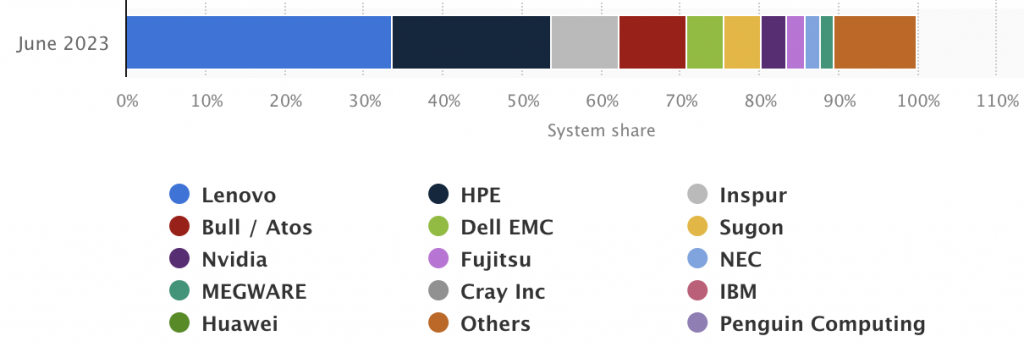
As of June 2023, Lenovo is the leading provider of supercomputers resulting in a share of 33.6% followed by HPE (20%) and Inspur (8.6%).
(Source: Statista)
#11. China had 173 of the 500 most powerful supercomputers as of November 2021.
Even though it might appear impressive, it represents a significant decline from the 214 out of 500 it had a year earlier. China is still the country with the most supercomputers, regardless of the date.
With 149 out of 500, the US is currently in second place, compared to just 113 in November 2020. Smaller nations saw the most significant increases in the total number of supercomputers owned— their combined count jumped from 45 to 54.
Don't worry if you have already begun to fret about China. The nation still possesses the most powerful supercomputers on the entire globe. Thus their systems aren't in danger. But we'll talk more about that later.
(Source: Statista)
World's Most Powerful Computers
Even if the list hasn't undergone any big changes recently, that doesn't imply we don't anticipate any. Let's examine some of the most powerful computers currently in use and make future projections.
#12. The Chinese Oceanlite supercomputer boasts a peak performance exceeding 1.3 exaFLOPS.
Even Sunway TaihuLight, the most powerful public supercomputer in China, has a successor. Although its supercomputer specifications aren't made public, they are almost impossible to imagine.
The Linpack benchmark shows that Oceanlite can reach a peak performance of 1.3 exaFLOPS. Even when performing continuously, it has an average computing power of 1.05 exaFLOPS. It is, however, not an energy-saver as it uses a staggering 35 megawatts of electricity.
China wants to achieve 20 exaFLOPS by 2025, demonstrating its lofty aspirations for the supercomputer industry. However, this doesn't mean the US is in a state of stagnation.
(Source: DCD)
#13. Every June and November, the TOP500 organization ranks among the top 500 supercomputers in the world.
These rankings were created in 1993. The 58th edition was published in November 2021. The 2022 TOP500 supercomputer list is still not available, so we'll be listing the most recent one:
- Fugaku
- Summit
- Supercomputer Fugaku
- Sunway Taihulight
- Sierra
- Selene
- Perlmutter
- JUWELS Booster Module
- Voyager-EUS2
- HPC5
- Tianhe-2A
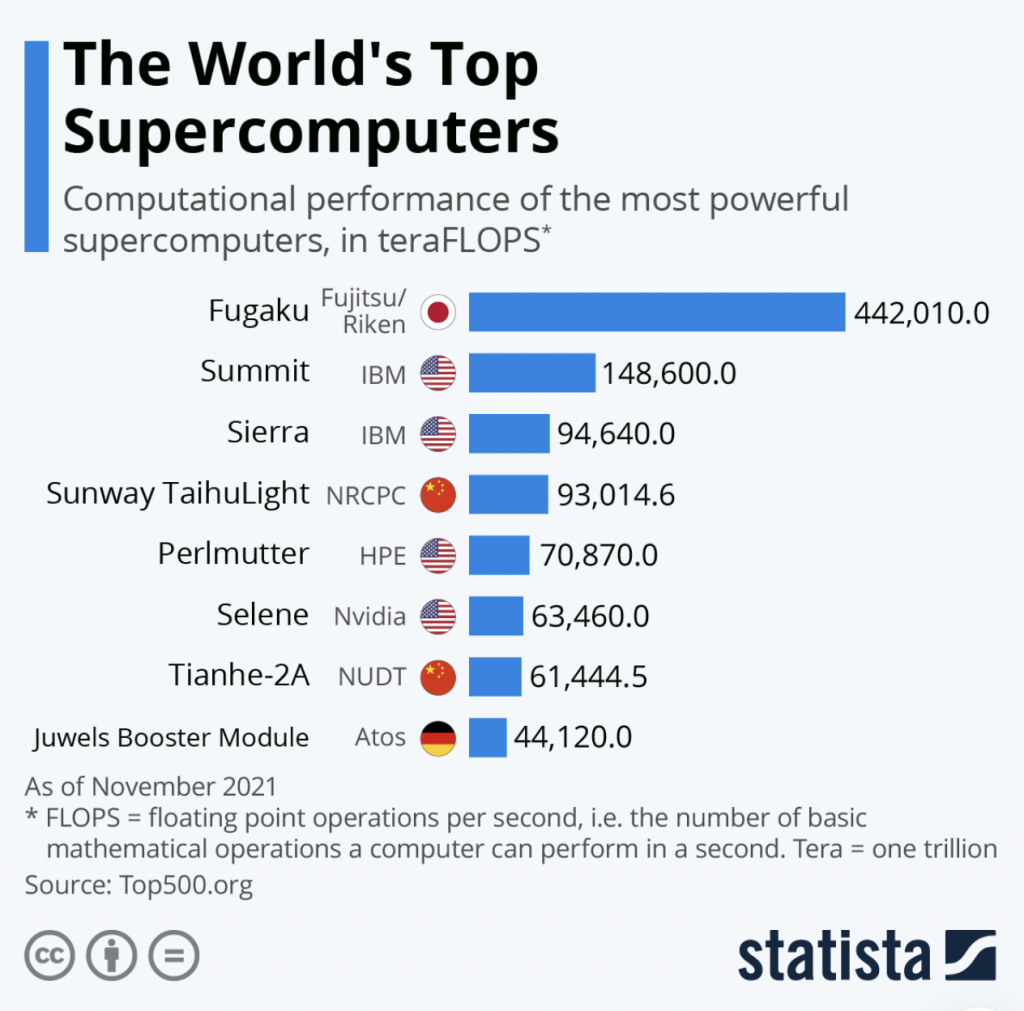 (Source: TOP500)
(Source: TOP500)
#14. Right now, Frontier is the world's most powerful computer in 2022.
The United States intends to introduce Frontier, a brand-new supercomputer. It is rumored to have a sustained performance of roughly 1.3 exaFLOPS and a peak performance of 1.5 exaFLOPS. Additionally, it appears to use only 29 MW of electricity.
If it launches soon, it will be the first exascale supercomputer available to the general public and the new strongest supercomputer. We are still waiting to see it, but we anticipate that two other American supercomputers- the long-delayed El Capital and Aurora, two exaFLOP systems are scheduled to launch in 2023.
Number of computer cores in the ten world's fastest supercomputers in 2022
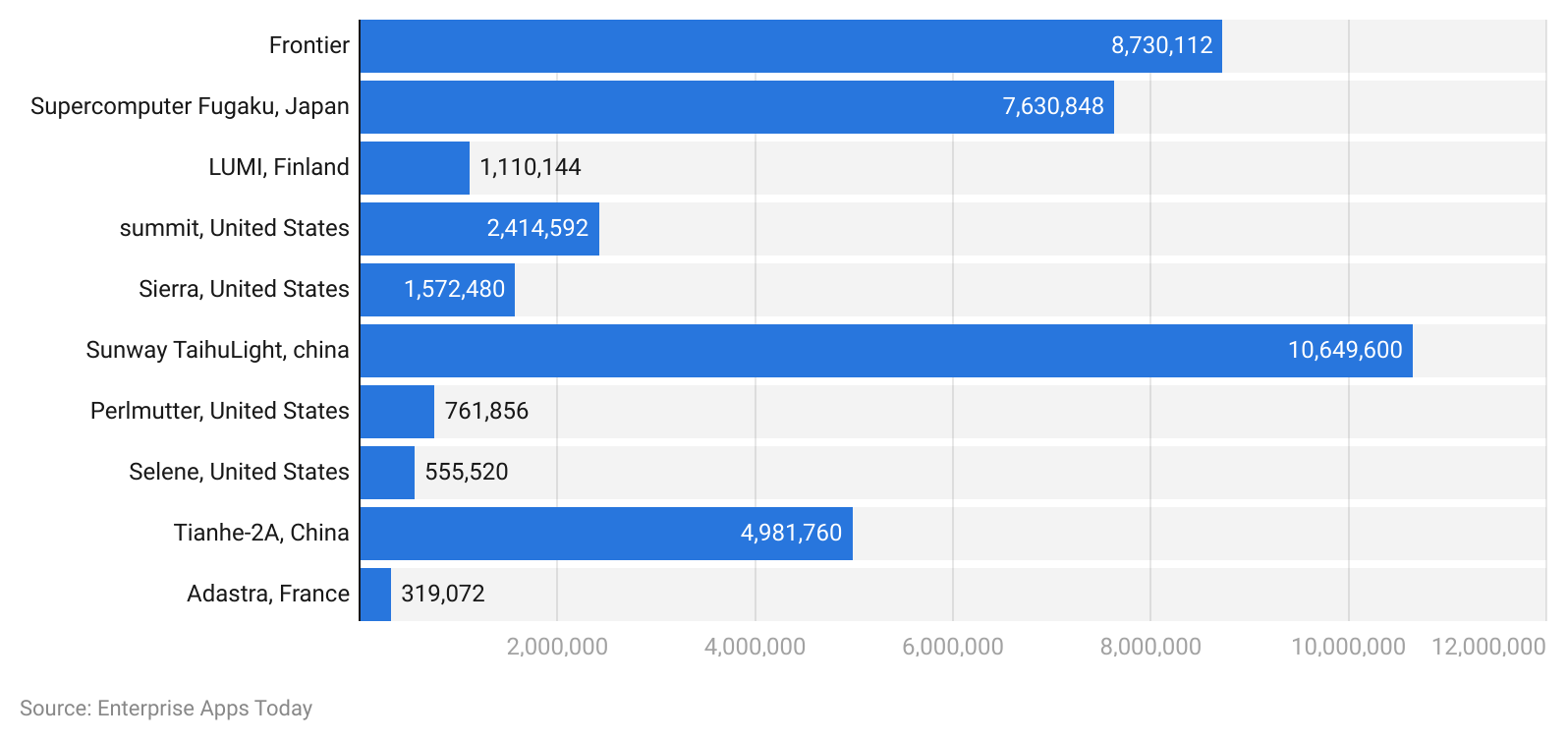
(Source: DCD)
#15. The world's fastest supercomputer is called Fugaku.
The strongest public supercomputer in the world is still Fujitsu's Fugaku, which has a peak performance of 442 petaFLOPS. The summit isn't even close with its “measly” 148 petaFLOPS. Sierra is even closer at just 94.
However, there are rumors that China has two secret supercomputers even stronger than the one that is being claimed. Both are exascale, which means they will exceed the 1,000 petaFLOPS mark.
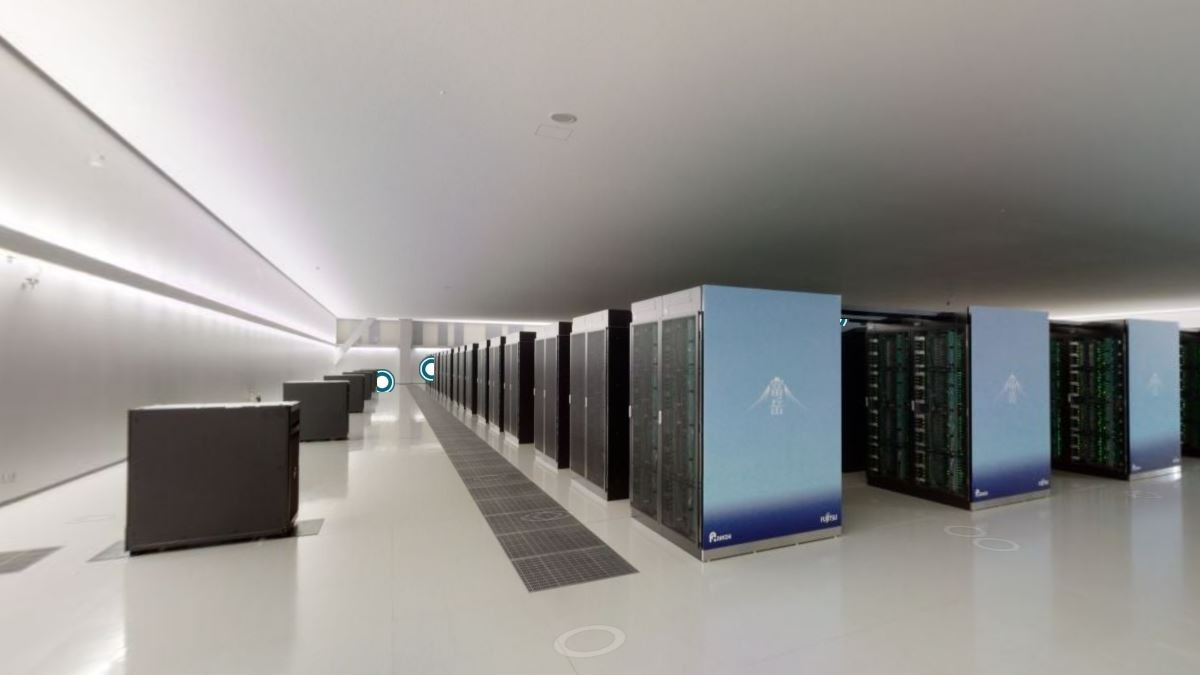
(Source: DCD)
#16. By country, the distribution of the 500 strongest supercomputers in the world between 2019 and 2022.
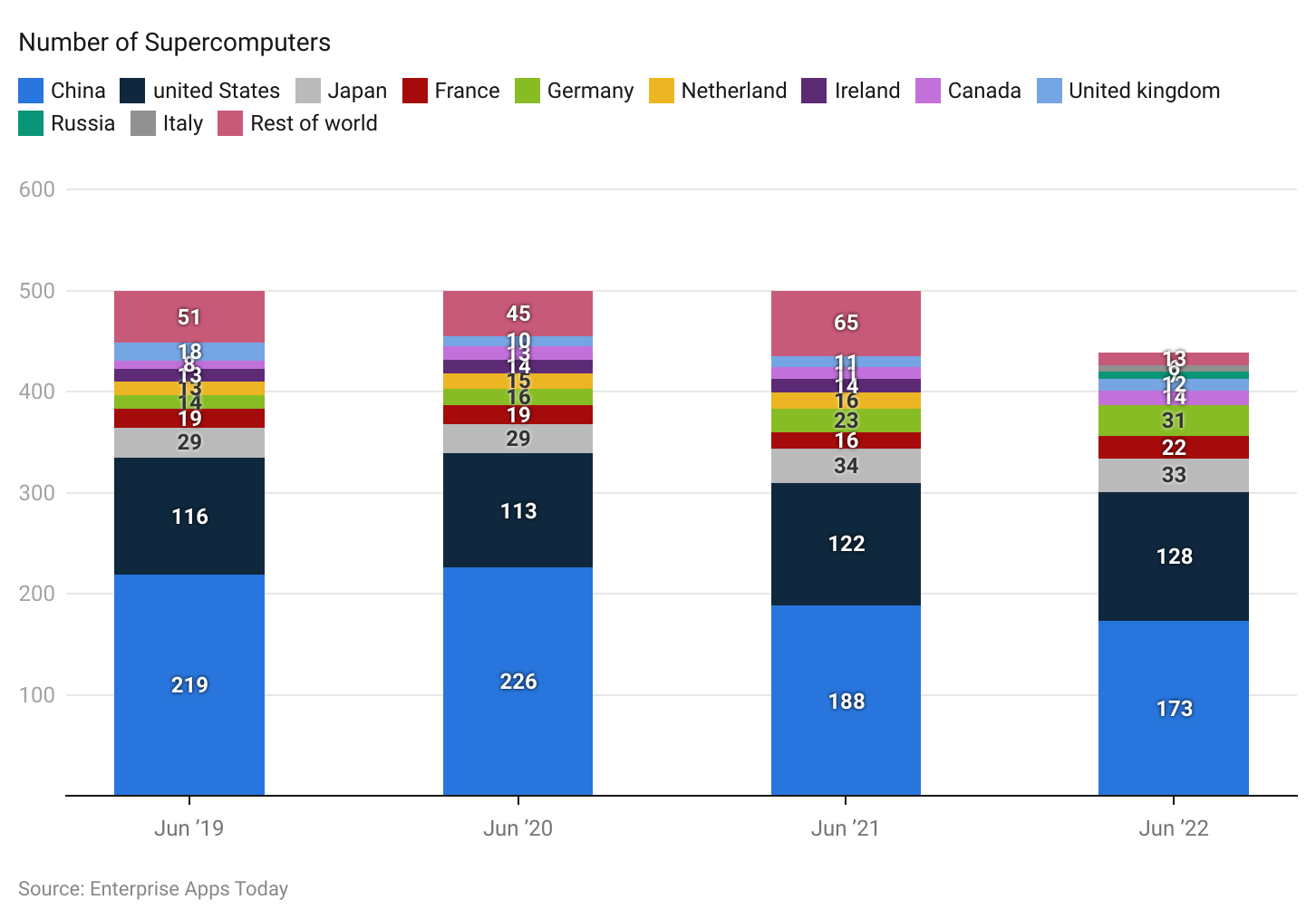
Conclusion
This concludes our today's discussion of supercomputers. We hope our collection of the most essential and fascinating supercomputer stats has given you a better understanding of their expanding popularity.
Additionally, supercomputers are constantly evolving to meet the needs of their users. In other words, supercomputers are an important part of our technological world. They are used for various purposes, from scientific research to national security. Also, supercomputers have become more powerful and faster over the years, and their capabilities are constantly expanding. While the specifics of how they work may be confusing to some, it is vital to have a basic understanding of their capabilities and uses.
Supercomputers are a vital part of our technological world. While the average person may not know much about these machines, it is essential to understand their impact on our lives. With continued advances in technology, likely, supercomputers will likely only become more important in the future. We can only hope that engineers find a way to make them use less energy because if they carry on in this manner, we might have to deal with a completely different threat!
Sources
FAQ.
The first supercomputer (CDC 6600) was built in 1964 by Seymour Cray. He is also known as the Father of a supercomputer.
Seymour Cray and Boris Babayan together invented and built the first world’s first supercomputer.
The CDC 6600, Control Data Corporation released in 1964 with a single CPU cost $8 million which is equivalent to $60 million today.
The term is used when computers are built with high-performance systems or any powerful computers.

Barry is a lover of everything technology. Figuring out how the software works and creating content to shed more light on the value it offers users is his favorite pastime. When not evaluating apps or programs, he's busy trying out new healthy recipes, doing yoga, meditating, or taking nature walks with his little one.



